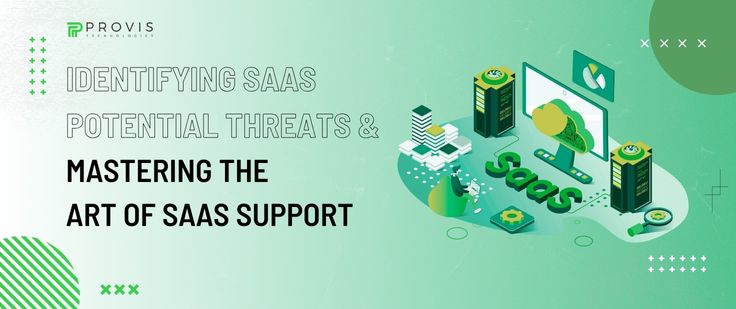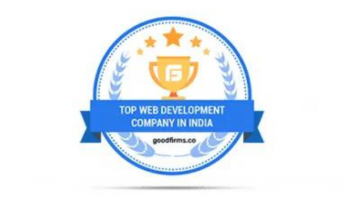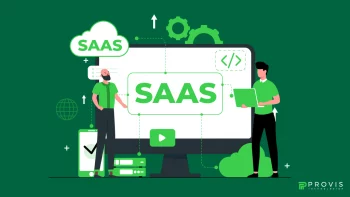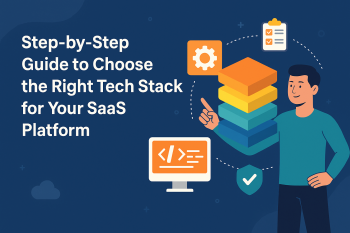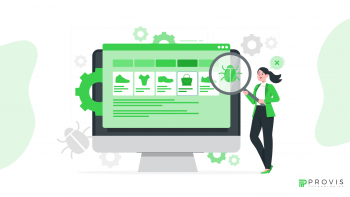Introduction
According to Statista, 232 billion U.S. dollars is the figure estimated to be touched by the SaaS market in 2024. One can clearly understand the value of SaaS services and support.
As businesses increasingly adopt Software as a Service (SaaS) due to its benefits, identifying & understanding its potential threats becomes the need of the hour. The dynamic nature of the cloud environment demands a vigilant approach to ensure the smooth operation of SaaS applications. Today, we will understand the strategies to identify potential issues and know their methods of resolution & support.
Part I – Understanding Threats
Regular Monitoring
Regular monitoring is the first step to identifying potential issues in a SaaS environment. Aspects like system performance, application health, and user behavior can be monitored using various advanced tools. Any deviations or anomalies can be promptly detected by establishing baseline metrics that help discover potential issues before they escalate.
User Behavior Analytics
Understanding how users interact with a SaaS application is crucial for identifying potential issues. User behavior analytics provide insights into usage patterns, preferences, and any irregularities that might indicate problems. Unusual spikes in activity, changes in usage patterns, or a sudden increase in error rates can be early indicators of potential issues that need attention.
Performance Metrics
Monitoring performance metrics & benchmarking against industry standards are effective ways to identify potential issues. This involves tracking response times, server latency, and other performance indicators. Deviations from established benchmarks can highlight areas that may require attention, enabling proactive measures to maintain optimal functionality.
Regular Audits & Assessments
Regular audits & assessments of SaaS infrastructure & applications are proactive measures to identify potential vulnerabilities. Security audits, compliance checks, and performance assessments help businesses ensure the SaaS environment is robust & resilient.
Also Read:- The Future of E-commerce: Embracing SaaS Solutions
Feedback Channels
Users can be valuable sensors in identifying potential issues & threats. Establishing effective feedback channels encourages users to report issues they encounter. Regularly collecting & analyzing user feedback establishes direct communication between the end users and the support & development teams, which enables swift responses to emerging issues.
Predictive Analytics
Predictive analytics leverages historical data & machine learning algorithms to anticipate future trends and potential issues. Analyzing these patterns helps businesses identify potential challenges before they impact the user experience. Predictive analytics can also be helpful in foreseeing capacity issues, resource constraints, or impending security threats.
Security Assessments & Threat Modeling
Regular security assessments and threat modeling exercises are essential in the cybersecurity space. This proactive approach involves identifying potential threats, evaluating their impact, and implementing measures to mitigate risks. Threat modeling helps organizations stay one step ahead of security threats in their SaaS applications.
Collaboration with Vendors
Collaboration with vendors is integral to identifying potential issues & threats for businesses relying on third-party SaaS solutions. Establishing clear communication channels and understanding the vendor’s security & compliance measures is crucial. Regular updates, security patches, and collaboration on best practices contribute to a shared responsibility for maintaining a secure SaaS environment.
Stay Informed
Remaining informed about the latest trends, vulnerabilities, and emerging threats in the SaaS space is essential. Subscribing to industry newsletters, participating in forums, and staying engaged with the broader tech community helps businesses remain ahead of the curve. This awareness allows organizations to address potential issues based on the collective knowledge and experiences of the industry.
Disaster Recovery Planning
While proactive measures are vital, preparing for the unforeseen is mandatory. Implementing disaster recovery plans ensures businesses can quickly recover and minimize the impact on operations during any mishap. Regularly testing & updating these plans guarantees their effectiveness when needed.
There are various methods & ways to identify SaaS potential threats when they arise or arrive. Now, let’s understand how to deal with them.
Don’t Miss:- How to Develop a SaaS Application? | The Complete Guide
Part II – Mastering the Art of SaaS Support
In the dynamic world of SaaS, where users demand & expect smooth experiences and uninterrupted access to their applications, the significance of support cannot be underestimated. Let’s know some great strategies for SaaS support and how they contribute to customer satisfaction & business success.
Round-the-Clock Availability
One of the pillars of SaaS support is the commitment to being available 24/7. Users access SaaS applications from around the globe, and downtime or issues can disrupt operations at any hour. Proactive support means being ready at all times, with a globally distributed support team ensuring that users receive timely assistance, irrespective of their time zone.
Predictive Issue Resolution
Predictive analytics & monitoring tools play a crucial role in proactive support. By analyzing data & patterns, support teams can identify potential issues before they escalate. This agile approach allows for the pre-emptive resolution of problems – reducing downtime and minimizing the business impact. It’s about fixing issues before users are even aware they exist.
Customer Education
Rather than waiting for users to encounter problems, providers should proactively offer resources that empower users to make the most of the SaaS platform. This includes training materials, webinars, documentation, emails, and tips to enhance the user experience and optimize SaaS application use.
Regular Updates & Enhancements
SaaS support also involves regularly updating the application with new features, enhancements, and bug fixes. Keeping users informed about these updates demonstrates your commitment to continuous innovation & responsiveness to their needs.
Proactive Communication
This involves spreading information to users by actively seeking their feedback. Regular communication through emails, in-app notifications, and social media helps keep users in the loop – while feedback channels provide valuable insights for improvement. This open dialogue builds a strong relationship between providers & users. Community building is a great way to establish long-term business relationships.
Feedback Channels
SaaS support encourages the creation of easy-to-use feedback channels, actively encouraging users to share their thoughts, concerns, and suggestions. Providers should view feedback as a catalyst for improvement, using it to refine their offerings, fix pain points, and enhance the overall user experience.
Empathy & Customer-Centric Approach
Proactive support is not just fixing technical issues – it’s also about understanding the user’s journey and empathizing with their challenges. A customer-centric approach involves actively listening to users, addressing their concerns promptly, and providing solutions that align with their needs.
Performance Monitoring
A proactive SaaS support strategy includes constant vigilance over the application’s performance. Performance monitoring tools help identify bottlenecks and ensure optimal speed, reliability, and scalability. Teams act swiftly to rectify performance issues to ensure users consistently experience the high-level performance they expect.
Security Vigilance
Security is a top priority in the SaaS domain. Proactive support involves keeping potential security threats at bay by implementing robust security measures and regularly updating protocols. Providers must maintain compliance with industry standards, assuring users that their data is secure & protected.
Collaboration with Development Teams
Support requires a joint effort between support & development teams. Insights gained from support interactions should be fed back to the development teams, influencing product updates and improvements. This collaboration ensures that the SaaS platform evolves in alignment with user needs and technological advancements.
Must Know:- 30 FAQs About SaaS Product Development
Bottom Line
In the competitive SaaS space, the art of proactive support distinguishes industry leaders from the rest. 24/7 support is a commitment to being available anytime your users need you. It’s also about anticipating, educating, communicating, and continuously evolving the user experience. As businesses increasingly rely on SaaS solutions, mastering the art of proactive support becomes a fundamental necessity for sustained success. Providers who embrace this art form empower their users, build strong relationships, and ensure their place at the forefront of the SaaS revolution.
Afterthoughts
Proactive support goes beyond traditional reactive measures, moving towards a strategy where potential issues are identified and resolved even before they get noticed by the users. The art of SaaS support is a commitment to continuous improvement, innovation, and putting the customer at the center of the experience. IT agencies like Provis Technologies have mastered this art of support & user satisfaction.
Written By
Author's Picks
- Knowing SaaS to the Core & a Complete Guide to Best SaaS App Development Methods
- 20/01/2024
- SaaS versus Traditional Software: Why SaaS Development Services Outdo Traditional?
- 06/11/2023
- Top 15 Software Development Trends to Follow in 2025
- 31/01/2025
Categories
- AI for Startups
- AI in Web Development
- AI Integration
- AI Platforms
- AI Prompt
- AI Tools
- AI Trading Software
- Android App
- Android vs iOS Development
- Angular
- API
- API Development
- App
- app development
- App Idea
- App User Feedback
- Application
- Artificial Intelligence
- Audit Services
- Automotive Industry
- Awards and Recognition
- Business Consulting
- Business Website
- Chatbots
- CRM
- CRM for Financial Advisors
- Custom CRM
- Custom SaaS
- Custom Website
- Customer Service
- dashboard design
- Developing a Mobile App
- Digital Business
- E-commerce
- EMR Integration
- Finance
- Financial Advisors
- Financial Advisors
- GIT
- Health Insurance
- iOS App
- iOS App Development
- IoT Mobile App Development
- IoT Platforms
- IT Audit Services
- IT Consulting
- IT Strategies
- Java Development
- Laravel
- Lean Canvas
- Learning Management System
- Logistics Apps
- Mobile App Development
- MVP
- Native App
- News Aggregator Site
- OTT
- Outsourcing IT
- Payment Gateway
- predictive analysis
- Product Launch Strategy
- Progressive Web App (PWA)
- Prototype
- Recommender Systems
- Ruby
- SaaS
- SaaS Application
- SaaS Business
- SaaS Company
- SaaS Development
- SaaS Product
- SaaS Project
- Sales Funnel
- SEO
- Shopping Cart
- Software Development
- SSL and TLS
- Startup Checklist
- Technology
- Tetradic Color Scheme
- UI/UX Design Company
- Unit Testing
- User Flow
- User Testing
- Web Development
- Web Performance Optimization
- website Maintenance Services
- Website Migration Service
- Website Speed Optimization
- WooCommerce
- WordPress
